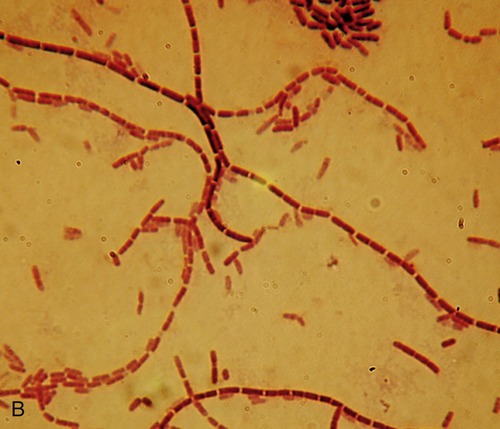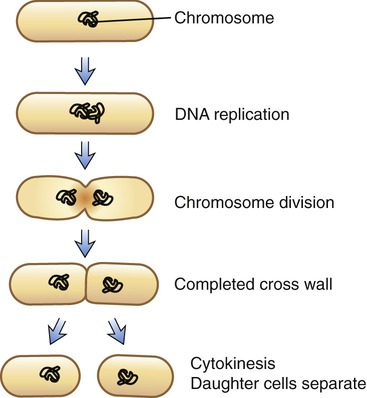Bacteria and Archaea
After reading this chapter, the student will be able to:
• Identify bacterial shapes and arrangements
• Discuss the basis of bacterial growth
• Explain the bacterial population growth curve
• Discuss factors that influence microbial growth
• Describe methods for measuring microbial growth
• Discuss the nutritional requirements for bacterial growth
• Discuss replication and expression of bacterial DNA
• Describe bacterial mutations and genetic transfer
• Describe the criteria used in the classification of bacteria
• Discuss medically important bacteria and their classification according to Bergey’s Manual
Bacterial Structure
Shapes
Bacterial cell morphology displays a variety of different shapes and sizes (Figure 6.1), and the cells are generally much smaller than eukaryotic cells. According to their morphological characteristics most bacteria are classified into different basic shapes: coccus, bacillus, spirochetes (spiral or helical), and pleomorphic (see Chapter 4, Microbiological Laboratory Techniques).

• Cocci (singular, coccus) are bacteria whose overall shape is spherical or nearly spherical (Figure 6.2). Several cocci are human pathogens causing, for example, urinary tract infections, food poisoning, toxic shock syndrome, gonorrhea, some forms of meningitis, throat infections, pneumonias, and sinusitis.
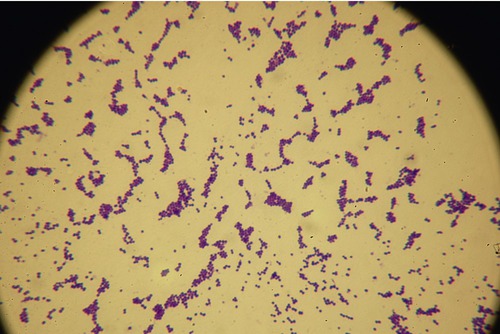
This gram-positive coccus, appearing as grapelike clusters, is one of the most common causes of staph infections.
• Bacilli (singular, bacillus) are rod-shaped bacteria, some of which are endospore forming (Figure 6.3). Diseases caused by bacilli include anthrax, botulism, and tetanus, and gastrointestinal infections caused by bacilli such as Escherichia coli and Salmonella.
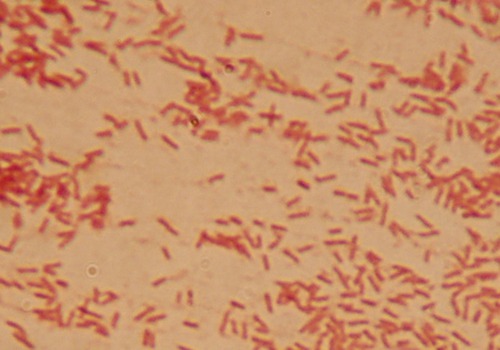
This micrograph shows a Gram stain of E. coli, a typical gram-negative bacillus.
• Pleomorphic bacteria are bacterial species that are morphologically indistinct, depending on environmental conditions. This group includes Coccobacillus (coccobacilli), which are bacilli that are elongated as well as spherical in shape (Figure 6.4).
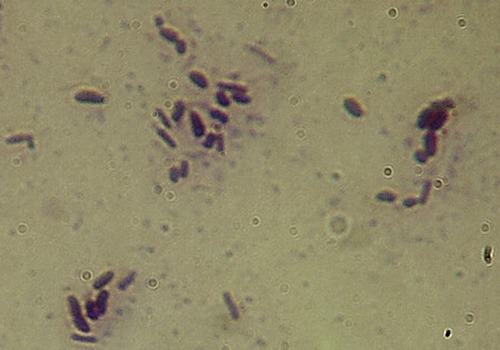
This micrograph illustrates a Gram stain of an organism from the genus Corynebacterium. The cells are variable in shape, from spheres to short rods, and therefore are considered pleomorphic (cells with a variable or indistinct shape).
• Spirals occur as vibrios, spirilla, or spirochetes.
• Vibrios are curved or comma-shaped rods (Figure 6.5) and several species are human pathogens associated with gastroenteritis, cholera, food poisoning, and septicemia. Vibrio fischeri and V. harveyi are symbiotes of marine organisms such as jellyfish and produce light via bioluminescence.

The micrograph shows a Gram stain of Vibrio natriegens, demonstrating the vibrioid shape, a simple curved rod. Note that not all cells appear curved, due to the viewing of the cells on the side with the convex/concave faces of the cell pointing directly at or away from the viewer.
• A spirillum (plural, spirilla) is a thick, rigid, spiral organism (Figure 6.6) that can cause rat bite fever, an uncommon but worldwide condition caused by rodent bites. These bacteria are present in the oropharyngeal flora of approximately 50% of healthy wild and laboratory rats, as well as in other rodents.
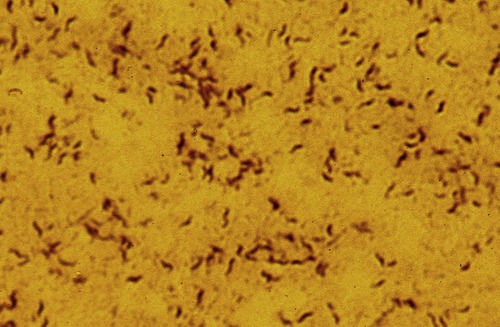
This micrograph is taken from a Gram stain of the genus Campylobacter, showing the corkscrew or “snakelike” shape referred to as spirilla. Although a spirilla and a spirochete may appear very similar in overall shape, the spirilla often have flagella as a means of locomotion, whereas the spirochetes have a structure called an axial filament that facilitates movement and lack flagella.
• Spirochetes are thin, flexible spirals (Figure 6.7) and can cause leptospirosis, Lyme disease, and syphilis.
HEALTHCARE APPLICATION
Examples of Pathogens and Opportunistic Pathogens by Shape
| Organism | Shape | Reservoir | Disease(s) |
| Staphylococcus aureus | Coccus | Common on skin, nose, gastrointestinal and urogenital tracts of humans | Toxin mediated: Food poisoning, scaled skin syndrome, toxic shock syndrome, folliculitis, carbuncles, impetigo, wound infections, bacteremia, and more |
| Staphylococcus epidermidis | Coccus | Common on human skin | Bacteremia, endocarditis, urinary tract infections, opportunistic infections of catheters, shunts, prosthetic devises, and more |
| Enterococcus faecalis | Coccus | Common in human gastrointestinal tract | Bacteremia, endocarditis, urinary tract infections, wound infections |
| Bacillus anthracis | Bacillus | Soil organism | Anthrax |
| Bacillus cereus | Bacillus | Soil organism | Toxin mediated: Gastroenteritis (emetic, diarrheal), ocular infections, opportunistic infections |
| Bacillus thuringiensis | Bacillus | None (soil, gut of caterpillars, butterflies, moths) | Gastroenteritis, opportunistic infections |
| Haemophilus influenzae | Pleomorphic | Mucous membranes of humans | Meningitis, epiglottitis, pneumonia, bacteremia, opportunistic infections |
| Chlamydia trachomatis | Pleomorphic | Obligate intracellular human pathogen | Sexually transmitted: Prostatitis, epididymitis, cervicitis, pelvic inflammatory disease, urethritis, and more |
| Vibrio cholerae | Spiral (vibrio) | Estuarine and marine environments | Toxin mediated: Acute diarrheal illness |
| Spirillum minus | Spiral (spirillum) | Rodents | Rat bite fever |
| Borrelia burgdorferi | Spiral (spirochete) | Vector-borne, transmitted by ticks | Lyme disease |
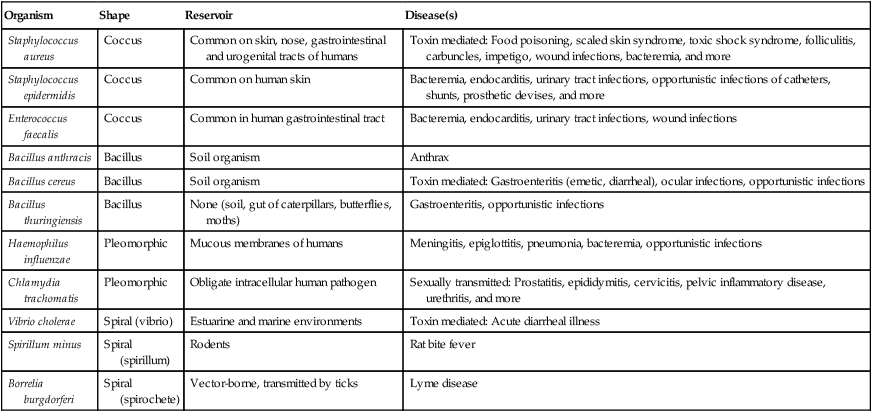
Arrangements
• Aggregations of cocci occur after cell division and can be classified as the following (Figure 6.8):

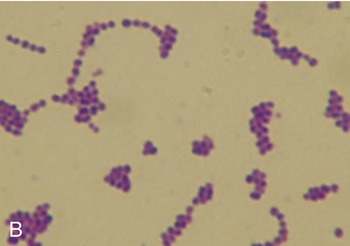
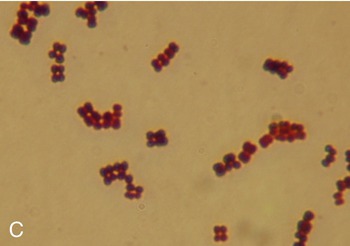
Cocci occur in five basic arrangements: diplo, in pairs; staph(ylo), in grapelike irregular clusters; strep(to), in chains; tetrads, in squares of four; and sarcinae, three-dimensional cubes. A, Staphylococcus; B, Streptococcus; C, Micrococcus in tetrads.
• Diplo– is a prefix typically describing cells that occur in pairs of two, joined in one plane only. Examples of diplococci are Streptococcus pneumoniae, Neisseria gonorrhoeae, and Neisseria meningitidis.
• Strepto– is a prefix used to indicate an arrangement of cells in beadlike chains, because cell division occurs along a single axis, in contrast to staphylococci, which divide along multiple axes. Individual species of Streptococcus are identified primarily on the basis of their hemolytic properties on blood agar. The species Streptococcus pyogenes is responsible for strep throat, many cases of meningitis, bacterial pneumonia, endocarditis, erysipelas (acute skin infection), and necrotizing fasciitis (“flesh-eating” infections).
• Tetrads are produced by division within two planes, with the cocci arranged in squares of four in irregular clusters. Micrococcus luteus, which can be found in many areas including the human skin, water, dust, and soil, shows this growth pattern. It is considered to be a harmless bacterium but some cases of Micrococcus infections have been reported in people with a compromised immune system (e.g., HIV patients).
• Sarcinae are cocci arranged in cubes of eight as a result of division in three planes. This coccal grouping occurs when any cocci fail to separate after they divide and the resultant daughter cells remain attached.
• Staphylo– is a prefix indicating arrangements in grapelike clusters formed by cell division in random planes. Most members of the genus Staphylococcus are harmless and are part of the normal flora of the skin and mucous membranes in humans. A small percentage of staphylococci are also part of the soil microbial flora. The organism can cause an array of diseases in humans and other animals by invasion and also by toxin production. The toxins of Staphylococcus are a common cause of food poisoning because the bacteria can grow in improperly stored food. Although the organism is killed by the cooking process, the enterotoxin is heat resistant and can survive boiling for several minutes.
• Bacilli divide in one plane, producing diplobacilli and streptobacilli (Figure 6.9).
Bacterial Growth
Growth is an increase in the quantity of cellular material and depends on the ability of the cell to form new protoplasm from available nutrients. Bacterial growth requires a source of energy for protein synthesis and to maintain bacterial metabolism. Bacteria must obtain or synthesize nucleic acids, carbohydrates, and lipids that are used as building blocks of cells. The minimal requirements for growth are a source of carbon and nitrogen, an energy source, water, and a variety of ions and minerals. Oxygen is necessary for some bacteria but can be lethal for many others (see Atmospheric Conditions, later in this chapter).
Basis of Bacterial Growth: Binary Fission
Bacterial replication is a coordinated process accomplished primarily by binary fission. Binary fission results in two identical daughter cells (Figure 6.10). In order for growth to occur sufficient metabolites are necessary to support the synthesis of bacterial components. A cascade of regulatory events must occur to initiate replication. Once replication is started DNA synthesis must run to completion. Chromosome replication starts at the plasma membrane and each daughter chromosome is anchored to a different portion of the membrane. Membrane, peptidoglycan synthesis, and cell division are linked together and as the bacterial membrane grows, the daughter chromosomes are pulled apart. At the end of chromosome replication septum formation between the daughter cells starts, indicating cell division (see Chapter 3, Cell Structure and Function). New initiation may begin even before chromosome duplication and cell division are complete.
Population Growth Curve
To produce a bacterial culture in a laboratory environment, the organism must be added to a medium (see Types of Culture Media in Chapter 4, Microbiological Laboratory Techniques). Under favorable conditions a growing bacterial culture doubles at regular intervals. Under ideal conditions, bacterial growth can be described by four different phases: the lag phase, the exponential or logarithmic growth phase, the stationary phase, and the death phase (Figure 6.11).
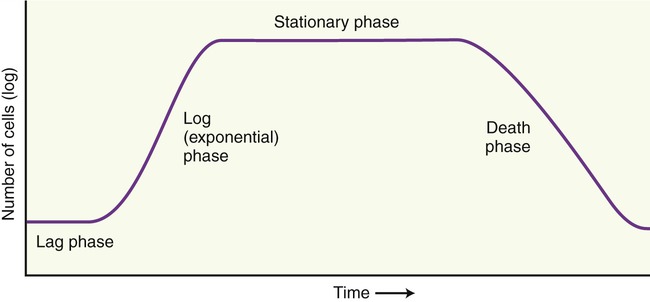
Bacterial growth can be described by four different phases: the lag phase, the exponential or logarithmic growth phase, the stationary phase, and the death phase.
• Lag phase: Bacteria must adapt to the medium before cell division starts. This period of time is referred to as the lag phase of the bacterial growth curve. During this phase the cells are metabolically active, producing molecules necessary for cell division; the individual bacteria are maturing, yet they are not able to divide at this time.
• Logarithmic or exponential growth phase: The rate of growth increases with time in the so-called logarithmic or exponential growth phase. Each cell introduced to the medium divides by binary fission into two cells. With each subsequent binary fission a doubling of the bacterial cells occurs as long as the growth conditions are favorable. The time required for doubling of the population is called the generation time. In other words the number of new bacteria per unit of time is proportional to the present population, and the actual rate of growth depends on the growth conditions, which directly affect the frequency of cell division.
• Stationary phase: A stationary phase occurs when essential nutrients are depleted or by-products of metabolism accumulate. A depletion of nutrients causes cells to decrease in size and toxic metabolic by-products limit the ability to undergo cell division. During this phase the total number of viable cells remains constant. This phase of population growth can last for a few hours to several days, depending on the environmental conditions.
• Death phase: Finally, the death phase begins when growth stops and the number of dead cells is larger than the number of viable cells.
Measuring Growth
Measurement of Cell Mass
• Dry weight measurements allow a more accurate estimation of cell masses but are more time consuming and only useful when dealing with massive populations of cells. With this procedure the cells need to be washed thoroughly and then dried before weighing. The dry weight of cells is roughly 20% to 25% of their wet weight.
• Microbial growth in liquid media causes turbidity and can be measured with a spectrophotometer. The turbidity is measured in optical density (OD) units, which is the logarithm of the ratio of intensity of light striking the suspension to the amount that is transmitted. The greater the cell mass the less light will pass through the spectrophotometer, an instrument that can measure light intensity. Measurement of very large populations will require dilution in order to obtain accurate estimates of cell mass.
Measurement of Cell Number
• Direct (total) cell counts can be obtained microscopically in counting chambers known as Petroff-Hauser chambers (Figure 6.12). Such a chamber consists of a slide with a grid of 25 small squares etched within 1 mm2 under a coverslip.

Several different slide counting chambers are available including the Petroff-Hausser chamber, the Sedgwick-Rafter chamber, and the Neubauer chamber (pictured).
• Viable counts only count the viable cells in a culture and can be accomplished by:
Factors Influencing Microbial Growth
Nutritional Requirements
The nutritional requirements for different microbes vary significantly from one to another. Microorganisms that acquire energy from light are called phototrophs, and those that require chemical compounds for energy are called chemotrophs. The pathways for the generation of cellular energy are photosynthesis, fermentation, and respiration (see Chapter 3, Cell Structure and Function).



